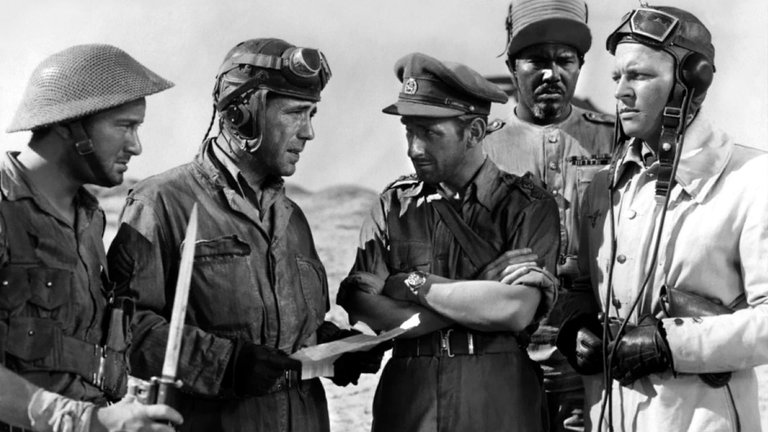Film Review: Sahara (1943)

Some of the best examples of effective Second World War propaganda can be found in Hollywood films. On the other hand, American film makers, despite having unmatched technical and financial resources and pool of talents, didn’t hesitate to take cue from someone else when it was warranted. The example can be found in Sahara, 1943 film directed by Zoltan Korda, known as first and one of the very few Hollywood films to be remake of a Soviet film.
The Soviet film in question was The Thirteen, 1936 action adventure film which is considered the first in specifically Soviet genre of “Ostern”, set in Central Asia during Russian Civil War. This version, however, has brought setting in time and place somewhat more closer to American audiences – North African desert in June 1942. Times are getting very tough for the Allies, whose British Eight Army has just suffered massive defeat at the hands of Rommel’s German forces and their Italian allies, and is now forced to retreat towards Egypt. Part of the Eight Army is small detachment of freshly arrived M3 Lee/Grant tanks, freshly arrived from USA with American crews that are to serve as advisors or gain experience for future combat. One of such tanks is “Lullaby”, commanded by Sergeant Joe Gunn (played by Humphrey Bogart) who, upon learning that most of the escape routes are cut off, decides to take chances by going southwards. Along the way they pick group of British stragglers led by Captain Haliday (played by Richard Aherne) and Free French soldier Jean Leroux (played by Louis Mercier). Later they are joined by British Sudanese Sergeant Major Timbul (played by Rex Ingram) and his Italian prisoner Giuseppe (played by J. Carroll Nash). When their tank is attacked by Luftwaffe fighter plane, they shoot it down and take Captain von Schletow (played by Kurt Kreuger), the pilot who ejected, as prisoner. The main issue happens to be lack of water, but the group manages to find soon-to-be-dried well where they take shelter. Later they learn that their location is on the path of German battallion whose commander Major Hans von Falken (played by John Wengraf) also wants to water for his men. Despite opportunity to escape and despite only having only nine men against 500 enemy soldiers, Gunn decides to stand and fight, reasoning that the delaying action could contribute to Allied forces regrouping and stopping Rommel.
Just like the Soviet original, Sahara has rather simple plot, which is more-or-less limited on single location. The number of characters is also limited, which, like with most good action films, allows them to be fleshed out before proper action begins and audience to wonder which one of them would survive the ordeal. Modern wartime setting, on the other hand, allowed film makers to add tank, half-track and fighter plane, which were provided by US Army, together with testing grounds in Californian desert. The film works very well as an action piece, but it also worked as propaganda, which is, somewhat ironically, more explicit than in Soviet original. Sahara very clearly tries to use the battle for the well as metaphor for the entire war and underline importance of Allied nations working together for the common goal. The defenders belong to different nations (USA, Britain, South Africa and France), and even include black Muslim, played by Rex Ingram, one of the rare African American actors who achieved something close to stardom in Classic Hollywood (and who best known for the role of Djinn in The Thief of Bagdad). None of the protagonists show any racist bias toward Timbul, unlike captured Luftwaffe pilot who is quickly silenced by Gunn. Sahara is, despite its clear propaganda purpose and ocasional slippage into melodrama not only effective, but realistic action film, and there aren’t any female characters. The only thing that takes away from realism are parts of dialogue, especially near the end when Sergeant Gunn makes motivational speeches reminding his men of sacrifices others had made during the war. Despite its limitations and role of Sergeant Gunn not being among the most iconic in his career, Humphrey Bogart later considered Sahara one of his favourite film. The rest of the cast was also good, with J. Carroll Nash in the role of Italian soldier who gradually turns against Fascism (almost prophetically, in light of Italy being capitulating shortly after the end of production) being nominated for Oscar for Best Supporting Role. Veteran cinemantographer Rudolph Maté with its stylish black-and-white photography also added a lot to the film. In 1995 an eponymous colour remake starring James Belushi was produced in Australia for cable television, but it turned out to be inferior to 1943 version.
RATING: 7/10 (+++)
Blog in Croatian https://draxblog.com
Blog in English https://draxreview.wordpress.com/
Leofinance blog https://leofinance.io/@drax.leo
Unstoppable Domains: https://unstoppabledomains.com/?ref=3fc23fc42c1b417
Hiveonboard: https://hiveonboard.com?ref=drax y
Bitcoin Lightning HIVE donations: https://v4v.app/v1/lnurlp/qrcode/drax
Rising Star game: https://www.risingstargame.com?referrer=drax
1Inch: https://1inch.exchange/#/r/0x83823d8CCB74F828148258BB4457642124b1328e
BTC donations: 1EWxiMiP6iiG9rger3NuUSd6HByaxQWafG
ETH donations: 0xB305F144323b99e6f8b1d66f5D7DE78B498C32A7
